Luciana Achugar and Amanda Loulaki present new solos in New York.
When is a solo not a solo? Or perhaps the question might be this: Is a solo ever a solo—given that anywhere from two people to an audience of hundreds might be watching a supposedly solitary performer having a private experience? Luciana Achugar’s new Otro Teatro was advertised as a solo, but, in fact, it was a solo with a very large cast. Members of the press were asked if they could treat the dance as if it were a thriller: no spoilers. But I find it next to impossible to tell you how intriguing and provocative the experience was without conveying anything about Otro Teatro except what happened during choreographer Achugar’s opening solo. (In any case, it’s not as if this were a work in which a person you thought was an animal-loving pizza chef turned out to be a sex maniac.) Too, a review of Otro Teatro’s performance at the Walker Art Center in Minneapolis was posted online some time before the piece opened at New York Live Arts.
The Uruguayan-born Achugar has said in interviews that she is interested in questioning the boundaries between performers and spectators. That, she certainly does in Otro Teatro. While our tickets are being scanned, a person hidden under a black covering of some sort, and is crouching in the entryway, bends down to kiss each spectator’s left shoe. Later we realize that this is the choreographer. The lipstick-red lines on her feet and hands is a giveaway, when she appears on the stage of this black-box space, still hidden under the fabric (it is, she said in an interview, a material from Uruguay that is used to shade plants).
Hers is solo dancing as a ritual and an ordeal. She wants us to be part of her struggle to get down to a kind of primality, to erase the distractions of civilization. Kinesthesia helps her in this mission. In darkness, she begins to sing long, held tones. The lights reveal that she’s still covered, huddled on the floor. The tones morph into syllables that sound like “oh-an-dee-yah,” and, rocking, she can chant these, alternating between two tones, as many as seven times without taking a breath. Rising and continuing to vocalize, she begins to travel in a circle, revolving as she goes. A circle of lights overhead must be guiding her limited vision. I feel dizzy just watching her; it hurts to hear her occasionally gasp for breath, to see her pause or stagger a little as she enlarges and contracts her circle. Trying to stay in an orbit of her own devising, she looks at times lost in space. Once, she bumps into the back wall. The bell-like fabric turns gold in the lights and billows out around her. If she were a snake, she would have been out of her skin by now.
After a while, the theater begins to stir, to come alive. Behind me and around me, scattered voices moan softly or sigh or gasp. It’s a wonderful moment. I think of a forest of birds beginning to waken as the sky gets light. When Achugar comes forward on flat, rapidly vibrating feet, someone ululates in a high register. We spectators crane to see where the sounds are coming from.
The last work of Achugar’s that I saw was titled Puro Deso, and Otro Teatro, in its otherness as theater, also surges with desire. In lieu of a program, we’ve been given a short statement that begins, “To grow ourselves a new body. To give our body their voice back, with a practice of pleasure. . . .” Finally resting on the floor again, she begins to reveal herself—now a swatch of disheveled hair appears, now her red-smeared face with its challenging gaze. She really does begin to shed her skin; it’s a struggle, but a sensual one. Rolling, stretching, twisting, her naked body emerges from the dark covering as if she’s not entirely eager to leave it behind. On her hands and knees, she slides on it, pushing it along. When she undulates her spine, she looks like the earth heaving. Finally she breaks free of her sheath.
Those contributing the orgasmic hubbub do not sit still. Before long, two seats away from me, a woman I had assumed was a spectator like me until she started to sigh, has slipped out of some of her clothes and is crawling on her belly through the narrow space between my toes and the back of the row in front of me, where she rests for a while. Across the aisle, another woman has discarded her shoes and slid down in her seat, squirming slowly, lost in an apparently erotic dream.
I don’t tally the number of people who have been “planted” in the seats usually reserved for spectators and given guidelines for their improvisings, but by the end of Otro Teatro, there seem to be almost as many of them as there are of us. There are planned-for arrivals—like seedlings that have escaped from the mothering solo. At some point, you notice another person in a black bag crawling in the dimness by the back wall. This person and Achugar (once again covered), pressed together, turn around the circle as a unit. Later, free of the cloth and in dim light in a far corner, she (it is Jennifer Kjos) echoes a repeated movement that Achugar introduced earlier; lying on her back, with her feet toward us, she raises her naked legs, opens them wide, bends them, and brings them together so that she can do the pattern again. It looks like a breaststroke with the arm movements done by legs.
The audience’s efforts and vocal sounds are arranged to become furious or to simmer down. At its decibel peak, selected people bang on the backs of the seats in front of them and then on the walls More and more of those identified in the program that we’re handed (only as we exit the theater) leave their seats and join those onstage. Form decides to take chaos into account. The now familiar and the spontaneous mix it up. Learned motifs drop into a stew of activity. So do some garments. Everyone appears to make choices that may or may not involve others. A circle of runs and leaps, a stamping dance, a crotch display, climbing a pole. Soft drinks appear to be available just offstage.
Through most of this gentle orgy of activity, a gray-haired, bearded man (Michael Mahalchick) calmly unreels pale tape to create on the back wall what could be a graph of peaks, valleys, and crevices. Others to collect rolls of tape and continue his design on the floor and up other surfaces. It’s a fine example of individuals working eagerly on a collective project without an overall plan in mind. In the end the vocal noises are supplanted by raucous music, and, by the time I left, the boundaries between watchers and doers seemed to have eroded completely.
Otro Teatro will change wherever it is performed, since different people will be recruited and who knows how many might, in the last few moments, enlist uninvited. There will always be surprises. (To Hilary Clark: please note that I’m not mentioning the action you instigated six feet from me—just to show I can keep a secret).
No one would deny that Amanda Loulaki’s Forested is the kind of solo we know how to define. She’s alone in the scarred white brick box of the Chocolate Factory, exploring the nearly empty space that’s colored by Joe Levasseur’s lighting and Tei Blow and Levasseur’s complicit sound design. However, we are included in the penetrating stare she directs toward us us for moments at a time. More importantly, we occasionally sense slivers of narrative and hints of characters inserted into what is apparently a study in movement and form.
In addition to the Chocolate Factory’s radiators, with their flaking silver paint, there are two objects marooned in whiteness. One is a pillar made of spring-green carpet; it’s about 16 inches in diameter and maybe five feet tall. To the right of it and some distance away from us sits what looks like a tiny humanoid toy of some kind. A diagonal beam of light leads past the pillar to the toy and beyond.
Forested is very spare in terms of movement—clear, carefully designed. But it is also an ordeal. When Loulaki crawls backward toward one of the side walls and kicks her one leg repeatedly into the air behind her, she does so with such powerful force that you expect the wall to cringe. She performs this action twice over the course of the hour-long work.
From the moment Loulaki enters, dressed all in black, she displays two basic personas. One is the choreographer-performer who gets up off the floor or walks to a new place in the room with matter-of-fact purpose. The other is a woman who enters enter a zone of recollection imagination, where her movements refer to events in her life (she was, by the way, born and raised in Crete). So pared down are these that we can’t really know what they are. That’s not a liability; it’s what this intense choreographer-performer wishes, and the result of her style. Watching the move described above, we don’t need to know who or what she was kicking, why she was doing it, and who (or what) she was when she did it.
From the beginning, she establishes every move as arduous, important, something we need to watch. After walking in, tipping the green pillar and rolling it away, she lies down quite close to the audience. While she’s prone, we can watch her left hand slide very slowly toward us and stop, her bent and spread fingers slightly off the floor. Then she lifts her head, braces her arm on her elbow, rests her cheek on her right hand, and contemplates us. She has unnerving (and beautiful) eyes; they look almost rectangular and are paler than you expect them to be. For quite a few minutes, she tilts or turns her head, changes her gaze, raises her left leg from the knee down, bows her head onto her left arm. Occasionally, as Forested progresses, she moves her hands along the floor in a series of small jerks in time with the punishing drum beats of this part of the score.
For a while, she explores traveling along the floor on her hands and knees or balancing on her head, forearms and straight, slanted legs. She rolls with her legs knotted together. Her gestures suggest scooping up at one point, or swimming; then, on her feet and looking cross, she’s pushing someone or something away. When the music ceases its driving rhythm and becomes more atmospheric, it signals changes in the weather of the dance, with here a snapping sound, there a rumble, or a noise like that of an airplane engine becoming closer and then diminishing. The lights too change our perspective. When Loulaki stands facing the back wall, seven lamps on the floor right in front of the first row of spectators give her a shadow partner. As she backs toward us on swaying tiptoe, the lighting becomes gradually more mellow, and the shadow grows, pales, and vanishes.
Eventually we discover what the small obect is. Loulaki picks it up, rolls the green pillar toward us, drapes herself backward over it, and winds the thing up. It turns out to be a mounted cowboy, whose horse makes a rocking gallop travel minimally in a circle. The music amplifies his rhythms and continues after his tiny motor has run down. She winds him up again and continues to watch him from her upside-down perspective.
When she abandons him and rolls herself and the pillar upstage, she positions herself so that we see only her legs sticking up from behind it, as if someone had snapped a photo of her while she was falling head first into a ditch. At this point the lights begin fluctuating between brightness and dimness.
As I mentioned, her transitions have an everyday look. She leaves the performing area for a moment and returns holding what turns out to be a slim plastic jump rope, so transparent that when she begins to jump with mechanical rapidity, its arcs are barely visible. She walks toward the audience carrying the grassy pillar; then, lying on her back, she reaches up and backward to fit it (it turns out to be a hollow tube) over one of the lamps at our feet. What is she shining it on? We’ll never know. After that, she tosses and catches the pillar a number of times before setting it on end and swaying side to side, ever more loosely and expansively. She ends up collapsed beside it.
Gazing at Forested is like watching someone who has rummaged in the attic of her mind, selected some remembered moments, brushed them off, bleached them in the sun, and brought them unstained—fresh and white—to show us.

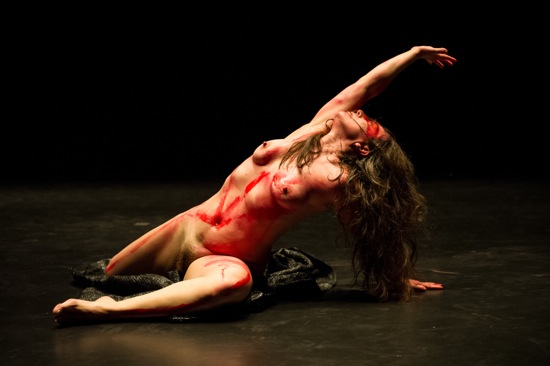
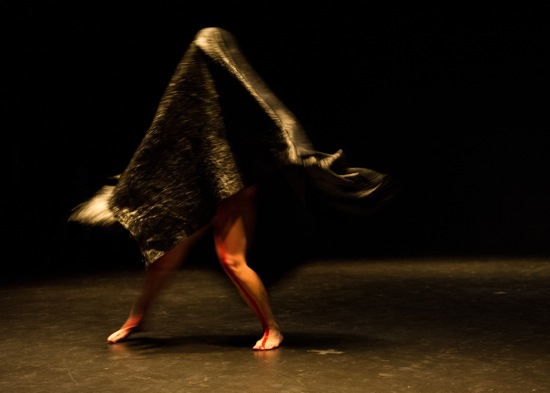
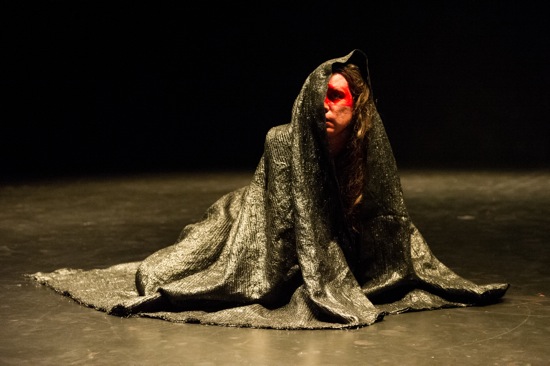
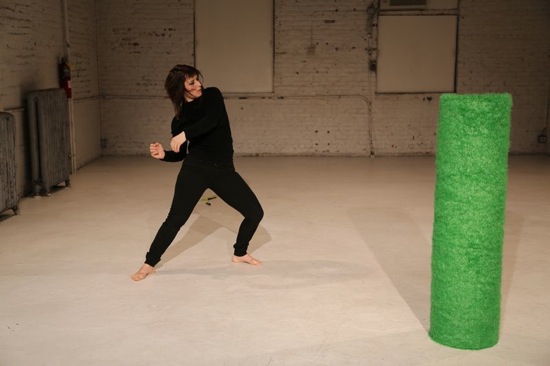
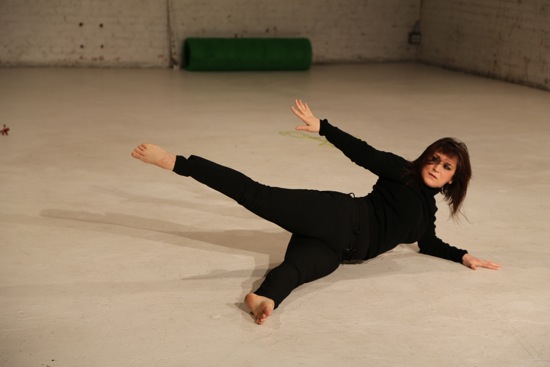
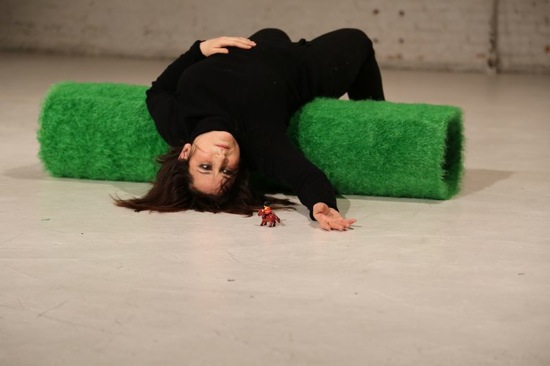
Otro Teatro sounds like the kind of performance that inspired my late husband to say to me, whenever I asked if he wanted to attend a modern dance event with me, in an apprehensive voice, “Are they going to slither?” Sounds like there was slithering a’plenty in this one. And me, I’m afraid of snakes.